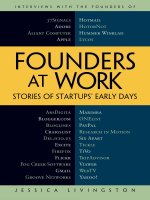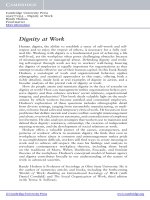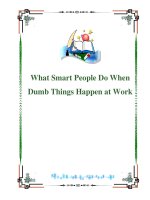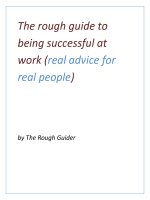JSON at work
Bạn đang xem bản rút gọn của tài liệu. Xem và tải ngay bản đầy đủ của tài liệu tại đây (9.72 MB, 374 trang )
JSON
at Work
PRACTICAL DATA INTEGRATION FOR THE WEB
Tom Marrs
JSON at Work
Practical Data Integration for the Web
Tom Marrs
Beijing
Boston Farnham Sebastopol
Tokyo
JSON at Work
by Tom Marrs
Copyright © 2017 Vertical Slice, Inc. All rights reserved.
Printed in the United States of America.
Published by O’Reilly Media, Inc., 1005 Gravenstein Highway North, Sebastopol, CA 95472.
O’Reilly books may be purchased for educational, business, or sales promotional use. Online editions are
also available for most titles ( For more information, contact our corporate/insti‐
tutional sales department: 800-998-9938 or
Editor: Meg Foley
Production Editor: Nicholas Adams
Copyeditor: Sharon Wilkey
Proofreader: Charles Roumeliotis
July 2017:
Indexer: Ellen Troutman-Zaig
Interior Designer: David Futato
Cover Designer: Randy Comer
Illustrator: Rebecca Demarest
First Edition
Revision History for the First Edition
2017-06-16: First Release
See for release details.
The O’Reilly logo is a registered trademark of O’Reilly Media, Inc. JSON at Work, the cover image, and
related trade dress are trademarks of O’Reilly Media, Inc.
While the publisher and the author have used good faith efforts to ensure that the information and
instructions contained in this work are accurate, the publisher and the author disclaim all responsibility
for errors or omissions, including without limitation responsibility for damages resulting from the use of
or reliance on this work. Use of the information and instructions contained in this work is at your own
risk. If any code samples or other technology this work contains or describes is subject to open source
licenses or the intellectual property rights of others, it is your responsibility to ensure that your use
thereof complies with such licenses and/or rights.
978-1-449-35832-7
[LSI]
To everyone who produces or consumes JSON data with web/mobile applications, REST
APIs, and messaging systems—I hope this makes your job easier.
To the unsung JSON community that produces JSON-based tools and libraries for the
rest of us—thank you for all your hard work to make JSON useful and meaningful.
Table of Contents
Preface. . . . . . . . . . . . . . . . . . . . . . . . . . . . . . . . . . . . . . . . . . . . . . . . . . . . . . . . . . . . . . . . . . . . . . xiii
Part I.
JSON Overview and Platforms
1. JSON Overview. . . . . . . . . . . . . . . . . . . . . . . . . . . . . . . . . . . . . . . . . . . . . . . . . . . . . . . . . . . . . 3
JSON Is a Standard
A Brief Sample
Why JSON?
Core JSON
JSON Data Types
JSON Value Types
JSON Versions
JSON Comments
JSON File and MIME Type
JSON Style Guidelines
Our Example—MyConference
Our Technical Stack
Our Architectural Style—noBackEnd
Model JSON Data with JSON Editor Online
Generate Sample JSON Data with JSON Generator
Create and Deploy a Stub API
What We Covered?
What’s Next?
3
4
6
8
8
11
14
14
14
15
17
17
17
18
20
20
24
24
2. JSON in JavaScript. . . . . . . . . . . . . . . . . . . . . . . . . . . . . . . . . . . . . . . . . . . . . . . . . . . . . . . . . 25
Node.js Setup
JSON Serialization/Deserialization with JSON.stringify() and JSON.parse()
25
26
v
The JSON Stringifier/Parser Object
JSON Serialization with Simple JavaScript Data Types
JSON Serialization with an Object and toJSON()
JSON Deserialization Using eval()
JSON Deserialization with an Object and JSON.parse()
JavaScript Objects and JSON
Node REPL
Where to Learn More About JavaScript Objects
Unit Testing with a Stub API
Unit Test Style—TDD and BDD
Just Enough Unit Testing with Mocha and Chai
Setting Up the Unit Test
Unirest
Test Data
Speakers Unit Test
Building a Small Web Application
Yeoman
Iteration 1—Generate a Web Application with Yeoman
Iteration 2—Make an HTTP Call with jQuery
Iteration 3—Consume Speaker Data from a Stub API and Use a Template
How to Go Deeper with JavaScript
What We Covered
What’s Next?
26
26
29
30
31
32
33
35
35
35
36
36
36
37
37
39
39
41
45
49
54
55
55
3. JSON in Ruby on Rails. . . . . . . . . . . . . . . . . . . . . . . . . . . . . . . . . . . . . . . . . . . . . . . . . . . . . . 57
Ruby on Rails Setup
Ruby JSON Gems
JSON Serialization/Deserialization with MultiJson
The MultiJson Object
JSON Serialization/Deserialization with Simple Ruby Data Types
JSON Deserialization with Objects and MultiJson
A Word on Camel Casing and JSON
JSON Serialization with Objects and ActiveSupport
JSON Deserialization with Objects and ActiveSupport
Unit Testing with a Stub API
Just Enough Unit Testing with Minitest
Setting Up the Unit Test
Test Data
JSON and Minitest Testing with APIs
Speakers Unit Test
Further Reading on Ruby and Minitest
What Is Missing in the Unit Tests?
vi
|
Table of Contents
57
58
58
58
59
61
63
64
65
66
66
67
68
68
68
72
72
Build a Small Web API with Ruby on Rails
Choose a JSON Serializer
speakers-api-1—Create an API with Camel-Cased JSON
speakers-api-2—Create an API that Customizes the JSON Representation
Further Reading on Rails and Rails-based APIs
What We Covered
What’s Next?
73
73
75
82
84
84
84
4. JSON in Java. . . . . . . . . . . . . . . . . . . . . . . . . . . . . . . . . . . . . . . . . . . . . . . . . . . . . . . . . . . . . . 85
Java and Gradle Setup
Gradle Overview
Just Enough Unit Testing with JUnit
Java-Based JSON Libraries
JSON Serialization/Deserialization with Jackson
Serialization/Deserialization with Simple Java Data Types
Serialization/Deserialization with Java Objects
Unit Testing with a Stub API
Test Data
JSON and JUnit Testing with APIs
Build a Small Web API with Spring Boot
Create the Model
Create the Controller
Register the Application
Write the Build Script
Deploy the API
Test the API with Postman
What We Covered
What’s Next?
Part II.
85
85
87
87
88
88
91
96
96
96
100
101
103
104
105
107
107
108
109
The JSON Ecosystem
5. JSON Schema. . . . . . . . . . . . . . . . . . . . . . . . . . . . . . . . . . . . . . . . . . . . . . . . . . . . . . . . . . . . 113
JSON Schema Overview
What Is JSON Schema?
Syntactic Versus Semantic Validation
A Simple Example
JSON Schema on the Web
Why JSON Schema?
My Journey with JSON Schema
The Current State of the JSON Schema Standard
JSON Schema and XML Schema
113
113
114
114
115
116
117
117
117
Table of Contents
|
vii
Core JSON Schema—Basics and Tooling
JSON Schema Workflow and Tooling
Core Keywords
Basic Types
Numbers
Arrays
Enumerated Values
Objects
Pattern Properties
Regular Expressions
Dependent Properties
Internal References
External References
Choosing Validation Rules
How to Design and Test an API with JSON Schema
Our Scenario
Model a JSON Document
Generate a JSON Schema
Validate the JSON Document
Generate Sample Data
Deploy a Stub API with json-server
Final Thoughts on API Design and Testing with JSON Schema
Validation Using a JSON Schema Library
Where to Go Deeper with JSON Schema
What We Covered
What’s Next?
118
118
120
121
125
126
128
129
131
133
135
136
138
141
146
146
146
148
151
152
155
157
157
158
158
158
6. JSON Search. . . . . . . . . . . . . . . . . . . . . . . . . . . . . . . . . . . . . . . . . . . . . . . . . . . . . . . . . . . . . 159
Why JSON Search?
JSON Search Libraries and Tools
Honorable Mention
What to Look For
Test Data
Setting Up Unit Tests
Comparing JSON Search Libraries and Tools
JSONPath
JSON Pointer
jq
JSON Search Library and Tool Evaluations—The Bottom Line
What We Covered
What’s Next?
viii
|
Table of Contents
159
160
160
160
161
162
163
163
170
173
184
185
185
7. JSON Transform. . . . . . . . . . . . . . . . . . . . . . . . . . . . . . . . . . . . . . . . . . . . . . . . . . . . . . . . . . 187
Types of JSON Transformation
What to Look For in a JSON Transform Library
Test Input Data
JSON-to-HTML Transformation
Target HTML Document
Mustache
Handlebars
JSON-to-HTML Transformation Evaluations—The Bottom Line
JSON-to-JSON Transform
The Issues
JSON-to-JSON Transform Libraries
Honorable Mention
Target JSON Output
JSON Patch
JSON-T
Mustache
Handlebars
JSON-to-JSON Transformation Evaluations—The Bottom Line
JSON-XML Transformation
JSON-XML Transformation Conventions
The Issues with JSON-XML Transformation Conventions
XML-JSON Transform—The Bottom Line
JSON-XML Transformation Unit Test
What We Covered
What’s Next?
Part III.
187
188
189
191
191
192
198
204
204
205
205
205
206
207
213
217
219
221
222
222
231
231
233
235
235
JSON in the Enterprise
8. JSON and Hypermedia. . . . . . . . . . . . . . . . . . . . . . . . . . . . . . . . . . . . . . . . . . . . . . . . . . . . 239
Comparing Hypermedia Formats
Defining Key Terms
My Opinion on Hypermedia
Siren
JSON-LD
Collection+JSON
json:api
HAL
Conclusions on Hypermedia
Recommendations for Working with Hypermedia
Practical Issues with Hypermedia
240
241
241
242
244
249
250
254
259
260
260
Table of Contents
|
ix
Testing with HAL in the Speakers API
Test Data
HAL Unit Test
Server-Side HAL
Going Deeper with Hypermedia
What We Covered
What’s Next?
261
261
263
267
268
268
268
9. JSON and MongoDB. . . . . . . . . . . . . . . . . . . . . . . . . . . . . . . . . . . . . . . . . . . . . . . . . . . . . . . 269
What About BSON?
MongoDB Setup
MongoDB Server and Tools
MongoDB Server
Importing JSON into MongoDB
MongoDB Command Shell
Basic CRUD with mongo
Exporting from MongoDB to a JSON Document
What About Schema?
RESTful API Testing with MongoDB
Test Input Data
Providing a RESTful Wrapper for MongoDB
What We Covered
What’s Next?
269
270
270
270
271
273
274
277
280
281
282
282
285
285
10. JSON Messaging with Kafka. . . . . . . . . . . . . . . . . . . . . . . . . . . . . . . . . . . . . . . . . . . . . . . . 287
Kafka Use Cases
Kafka Concepts and Terminology
The Kafka Ecosystem—Related Projects
Kafka Environment Setup
Why Do I Need ZooKeeper?
Kafka Command-Line Interface (CLI)
How to Publish a JSON Message with the CLI
Start ZooKeeper
Start Kafka
Create a Topic
List Topics
Start a Consumer
Publish a JSON Message
Consume a JSON Message
Clean Up and Shut Down Kafka
Kafka Libraries
End-to-End Example—Speaker Proposals at MyConference
x
|
Table of Contents
288
288
289
290
290
291
291
291
292
292
293
293
294
295
295
297
297
Test Data
Architecture Components
Set Up the Kafka Environment
Set Up Fake Email Server and Client—MailCatcher
Set Up Node.js Project Environment
Speaker Proposal Producer (Send Speaker Proposals)
Proposal Reviewer (Consumer/Producer)
Speaker Notifier (Consumer)
Review Notification Email Messages with MailCatcher
What We Covered
297
299
300
301
302
302
302
308
313
315
A. Installation Guides. . . . . . . . . . . . . . . . . . . . . . . . . . . . . . . . . . . . . . . . . . . . . . . . . . . . . . . . . 317
B. JSON Community. . . . . . . . . . . . . . . . . . . . . . . . . . . . . . . . . . . . . . . . . . . . . . . . . . . . . . . . . . 335
Index. . . . . . . . . . . . . . . . . . . . . . . . . . . . . . . . . . . . . . . . . . . . . . . . . . . . . . . . . . . . . . . . . . . . . . . 337
Table of Contents
|
xi
Preface
JavaScript Object Notation (JSON) has become the de facto standard for RESTful
interfaces, but an ecosystem of little-known standards, tools, and technologies is
available that architects and developers can start using today to build well-designed
applications. JSON is more than just a simple replacement for XML when you make
an AJAX call. It is becoming the backbone of any serious data interchange over the
internet. Solid standards and best practices can be used to harness the energy and
enthusiasm around JSON to build truly elegant, useful, and efficient applications.
The only thing missing is a book to pull everything together. This book aims to help
developers leverage JSON so that they can build enterprise-class applications and
services. My goals are to promote the use of JSON tooling and the concept of mes‐
sage/document design as a first-class citizen in the fast-growing API community.
My journey into JSON began in 2007 when I was leading a large web portal project,
and we had to populate a drop-down list with several thousand entries. At that time, I
was reading Head First AJAX by Rebecca Riordan (O’Reilly), so I had a decent archi‐
tectural approach. AJAX would solve overall latency and page load issues, but what
about the data? I had been using XML successfully for several years, but it seemed
like overkill for the task at hand—moving data from the backend of a web application
to the View. Head First AJAX mentioned a new data format called JSON, and it
looked like the way to go. My team began looking into APIs that would convert our
Java objects into JSON, and chose the one that had the simplest and shortest JUnit
tests—the goal was to do the simplest thing that could possibly work. We put the
application under rigorous load testing, and the Java-to-JSON conversion was never a
performance issue. The application scaled up in production, and the users saw their
drop-down list in a timely manner.
Along my journey, I considered the use of JSON with web applications, RESTful APIs,
and messaging. As of 2009, I was still working with XML because XML Schema pro‐
vided the semantic validation needed for meaningful data interchange. So, my posi‐
tion at that time was to use JSON for web user interfaces, or UIs (for speed), and
xiii
XML for Web Services and Messaging (for integration). But then I heard about JSON
Schema in 2010, and found that I had no further need for XML. The JSON Schema
specification is still under development, but it’s sufficiently mature enough now to use
for enterprise-class integration.
At this point, I was hooked on or, more accurately, obsessed with JSON. I began look‐
ing around the internet to see what else JSON could do, and I found copious APIs,
online tools, search capabilities, and more. In short, anything that has been done with
XML can (and should) now be done with JSON.
I then began to look for JSON in books, and was disappointed when I could find only
a chapter or two on the topic in a JavaScript or RESTful Web Services book. I saw a
growing JSON community along with lots of tool support and articles and blogs, but
there was no single place—other than Douglas Crockford’s JSON site—that pulled
everything together.
Audience, Assumptions, and Approach
This book is for architects and developers who design/implement web and mobile
applications, RESTful APIs, and messaging applications. Code examples are in Java‐
Script, Node.js, Ruby on Rails, and Java. If you’re a Groovy, Go, Scala, Perl, Python,
Clojure, or C# developer, you’ll need to follow along with the code examples pro‐
vided. But rest assured that most major/modern languages provide excellent JSON
support. For the architect, I’ve provided guidelines, best practices, and architecture
and design diagrams where appropriate. But in addition to providing visionary lead‐
ership, real architects prove their ideas with working code. While I love working with
JSON and writing code, it’s entirely meaningless without use cases, and a business
and technical context. For developers, this book is packed with code examples, tool‐
ing, and Unit Tests, along with a GitHub repository (see “Code Examples” on page
xvii).
Chapters 5–10 only have code examples only in Node.js to keep things simple and
focused. But it’s not hard to translate these examples into your platform of choice.
What Does “At Work” Mean?
When I wrote JBoss at Work with Scott Davis back in the mid-2000s, our vision was
to write a book that developers could use at work on their daily jobs. In the same
manner, the purpose of JSON at Work is to provide practical examples to developers
based on my real-world integration experience with JSON. To that end, I’ve baked
Unit Testing (wherever feasible) into every chapter. It’s simple: if there’s no test for a
piece of code, then that code doesn’t exist. Period.
xiv
| Preface
Expect to roll up your sleeves and look at code. Whether you’re an architect or devel‐
oper, you’ll find something here to help you on your job.
What You’ll Learn
By reading and following this book’s examples, you’ll learn how to do the following:
• JSON basics and how to model JSON data
• Use JSON with Node.js, Ruby on Rails, and Java
• Structure JSON documents with JSON Schema to design and test APIs
• Search the contents of JSON documents with JSON Search tools
• Convert JSON documents to other data formats with JSON Transform tools
• Use JSON as part of an enterprise architecture
• Compare JSON-based Hypermedia formats, including HAL and json:api
• Leverage MongoDB to store and access JSON documents
• Use Apache Kafka to exchange JSON-based messages between services
• Use freely available JSON tools and utilities to simplify testing
• Invoke APIs in your favorite programming language with simple utilities and
libraries
What You’ll Work With
Here’s a sample of the JSON tooling you’ll use in this book:
• JSON editors/modelers
• Unit-Testing tools (e.g., Mocha/Chai, Minitest, JUnit)
• JSON Validators
• A JSON Schema Generator
• JSON Search tools
• JSON Transform (templating) tools
Who This Book Is Not For
This book is not for you if your only interest in JSON is to make AJAX calls from
JavaScript. Although I cover this topic, it’s just the tip of the iceberg. Plenty of Java‐
Script books have the chapter you’re looking for.
Preface
|
xv
Developers looking for a deep reference on REST, Ruby on Rails, Java, JavaScript, etc.
won’t find it here. This book relies on these technologies, but focuses on how to use
JSON with these languages and technologies.
Organization
This book consists of the following parts:
• Part I, JSON Overview and Platforms
• Part II, The JSON Ecosystem
• Part III, JSON in the Enterprise
• Appendices
Part I, JSON Overview and Platforms
• Chapter 1, JSON Overview, starts with an overview of the JSON data format,
describes best practices in JSON usage, and introduces the tools used throughout
the book.
• Chapter 2, JSON in JavaScript, shows how to use JSON with JavaScript, Node.js,
and Mocha/Chai Unit Tests.
• Chapter 3, JSON in Ruby on Rails, describes how to convert between Ruby objects
and JSON, and integrate with Rails.
• Chapter 4, JSON in Java, tells you how to use JSON with Java and Sprint Boot.
Part II, The JSON Ecosystem
• Chapter 5, JSON Schema, helps you structure JSON documents with JSON
Schema. Along the way, you’ll generate a JSON Schema and design an API with
it.
• Chapter 6, JSON Search, shows how to search JSON documents with jq and
JSONPath.
• Chapter 7, JSON Transform, provides the tools you’ll need transform a poorly
designed JSON document to a better designed/more useful JSON document.
Plus, it shows how to convert between JSON and other formats such as XML and
HTML.
xvi
|
Preface
Part III, JSON in the Enterprise
• Chapter 8, JSON and Hypermedia, looks at how to use JSON with several wellknown Hypermedia formats (e.g., HAL and jsonapi).
• Chapter 9, JSON and MongoDB, shows how to leverage MongoDB to store and
access JSON documents.
• Chapter 10, JSON Messaging with Kafka, describes how to use Apache Kafka to
exchange JSON-based messages between services.
Appendices
• Appendix A, Installation Guides, shows how to install the applications you’ll need
to run the code examples in this book.
• Appendix B, JSON Community, provides further information and links to con‐
nect you to the JSON community (e.g., standards and tutorials) and to help you
go further with JSON.
Code Examples
All code examples for this book are freely available from the JSON at Work examples
GitHub repository.
This book is here to help you get your job done. In general, if example code is offered
with this book, you may use it in your programs and documentation. You do not
need to contact us for permission unless you’re reproducing a significant portion of
the code. For example, writing a program that uses several chunks of code from this
book does not require permission. Selling or distributing a CD-ROM of examples
from O’Reilly books does require permission. Answering a question by citing this
book and quoting example code does not require permission. Incorporating a signifi‐
cant amount of example code from this book into your product’s documentation does
require permission.
We appreciate, but do not require, attribution. An attribution usually includes the
title, author, publisher, and ISBN. For example: “JSON at Work by Tom Marrs
(O’Reilly). Copyright 2017 Vertical Slice, Inc., 978-1-449-35832-7.”
If you feel your use of code examples falls outside fair use or the permission given
above, feel free to contact us at
Preface
|
xvii
O’Reilly Safari
Safari (formerly Safari Books Online) is a membership-based
training and reference platform for enterprise, government,
educators, and individuals.
Members have access to thousands of books, training videos, Learning Paths, interac‐
tive tutorials, and curated playlists from over 250 publishers, including O’Reilly
Media, Harvard Business Review, Prentice Hall Professional, Addison-Wesley Profes‐
sional, Microsoft Press, Sams, Que, Peachpit Press, Adobe, Focal Press, Cisco Press,
John Wiley & Sons, Syngress, Morgan Kaufmann, IBM Redbooks, Packt, Adobe
Press, FT Press, Apress, Manning, New Riders, McGraw-Hill, Jones & Bartlett, and
Course Technology, among others.
For more information, please visit />
How to Contact Us
Please address comments and questions concerning this book to the publisher:
O’Reilly Media, Inc.
1005 Gravenstein Highway North
Sebastopol, CA 95472
800-998-9938 (in the United States or Canada)
707-829-0515 (international or local)
707-829-0104 (fax)
We have a web page for this book, where we list errata, examples, and any additional
information. You can access this page at />To comment or ask technical questions about this book, send email to bookques‐
For more information about our books, courses, conferences, and news, see our web‐
site at .
Find us on Facebook: />Follow us on Twitter: />Watch us on YouTube: />
xviii
|
Preface
Acknowledgments
First of all, I’d like to acknowledge Douglas Crockford for creating and standardizing
the JSON data format. JSON is the data language of REST and Microservices, and the
overall community is indebted to his vision and efforts.
I appreciate my O’Reilly editor, Megan Foley, and my former editor, Simon St. Lau‐
rent, for believing in this book and for their patience and guidance on the project.
Thanks for sticking with me and helping me throughout the project. I would also like
to thank my O’Reilly copy edit team, Nick Adams and Sharon Wilkey, whose diligent
work improved the quality of this manuscript.
Thanks to Matthew McCullough and Rachel Roumeliotis from the O’Reilly Open
Source Convention (OSCON), Jay Zimmerman from No Fluff Just Stuff (NFJS), and
Dilip Thomas from the Great Indian Developer Summit (GIDS) for giving me the
chance to speak about JSON and REST at your conferences. It’s always fun to speak at
conferences, and I hope to continue doing this well into the future.
I’m grateful to my technical reviewers who provided valuable feedback on this book:
Joe McIntyre, David Bock, Greg Ostravich, and Zettie Chinfong. I would also like to
thank the following people who helped shape and mold my ideas on how to talk
about JSON: Matthew McCullough, Scott Davis, Cristian Vyhmeister, Senthil Kumar,
Sean Pettersen, John Gray, Doug Clark, Will Daniels, Dan Carda, and Peter Piper.
The Colorado Front Range technical community is world class, and I’ve had fun pre‐
senting at the following user groups to help refine my material:
• HTML5 Denver
• Denver Open Source User Group (DOSUG)
• Colorado Springs Open Source User Group (CS OSUG)
• Denver Java User Group (DJUG)
• Boulder Java User Group (BJUG)
• BoulderJS Meetup
Thanks to my friends in the Toastmasters community who encouraged me, believed
in me, and pushed me to finish the book: Darryle Brown, Deborah Frauenfelder, Eli‐
nora Reynolds, Betty Funderburke, Tom Hobbs, Marcy Brock, and many, many oth‐
ers. You have inspired me to communicate clearly, to “Lift as You Climb,” and to
“Travel Beyond.”
There is an amazing JSON community on the internet. Much of this book is based on
the great work that you’ve done and continue to do. You’ve inspired me to tell your
story and to connect the dots.
Preface
|
xix
To my late parents, Al and Dorene Marrs, who loved me and always believed in me
and supported me—I know you’re in a better place. You inspired me to be adaptable,
to innovate, and to work hard. You always encouraged me to do my very best. Thank
you for everything you did for me.
Finally, to my beautiful wife, Linda, and my daughter, Abby—I love you. Thanks for
your patience with me while I spent my evenings and weekends on the manuscript
and code.
xx
|
Preface
PART I
JSON Overview and Platforms
CHAPTER 1
JSON Overview
The JavaScript Object Notation (JSON) data format enables applications to communi‐
cate over a network, typically through RESTful APIs. JSON is technology-agnostic,
nonproprietary, and portable. All modern languages (e.g., Java, JavaScript, Ruby, C#,
PHP, Python, and Groovy) and platforms provide excellent support for producing
(serializing) and consuming (deserializing) JSON data. JSON is simple: it consists of
developer-friendly constructs such as Objects, Arrays, and name/value pairs. JSON is
not limited to Representational State Transfer (REST); it also works with the follow‐
ing:
• Node.js (which stores project metadata in package.json)
• NoSQL databases such as MongoDB (see Chapter 9)
• Messaging platforms such as Kafka (see Chapter 10)
JSON Is a Standard
In the early days, REST’s detractors derided RESTful Web Services as being nonstandard, but (just like HTTP) JSON is in fact a standard. Both the Internet Engi‐
neering Task Force (IETF) and Ecma International (formerly the European
Computer Manufacturers Association, or ECMA) have recognized JSON as a stan‐
dard. Douglas Crockford originally created JSON in 2001, and initially standardized
it in 2006 under RFC 4627 through the IETF; see the JSON specification. In the fall of
2013, Ecma International also standardized JSON under ECMA 404; see their JSON
specification. With Ecma recognition (per Douglas Crockford; see his Google+ page),
JSON is now considered a formal international data processing standard.
3









